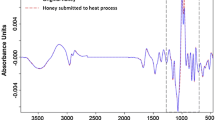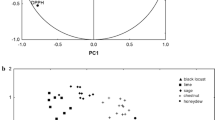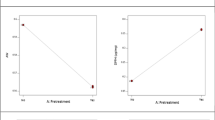Abstract
According to Box–Behnken design, 17 runs with five replicates were used to study the combined effect of temperature (60 to 80 °C), time (10–15 min) and pH (3–6) on the antioxidant properties (DPPH-radical scavenging activity (DPPH-RSA), TPC-total phenolic content and TFC-total flavonoid content) of saffron honey by employing response surface methodology. The statistical analysis showed that all three process variables significantly affect all the three responses. There was a statistical significant (p < 0.05) increase in all responses (DPPH-RSA, TPC and TFC) with the increase in time and temperature which resulted in increase in antioxidant activity. The antioxidant properties of saffron honey were significantly (p < 0.05) decreased with the increase in pH from 3 to 6. The results established that antioxidant activity was increased with the formation of browning pigments.


Similar content being viewed by others
References
National Honey Board, Honey Varietals, Available at: http://www.honey.com (2010)
N. Gheldof, N.J. Engeseth, J. Agric. Food Chem. 50, 3050–3055 (2002)
N. Gheldof, X.H. Wang, N.J. Engeseth, J. Agric. Food Chem. 50, 5870–5877 (2002)
A.M. Aljadi, M.Y. Kamaruddin, Food Chem. 85, 513–518 (2004)
V. Baltrusaityte, P.R. Venskutonis, V. Ceksteryte, Food Chem. 101, 502–514 (2007)
G. Beretta, P. Granata, M. Ferrero, M. Orioli, R.M. Facino, Anal. Chim. Acta 533, 180–191 (2005)
T.M. Little, F.J. Hills, Agricultural experimentation design and analysis (John Wiley, New York, 1978)
W. Mendenhall, Introduction to probability and statistics, 4th edn. (Duxbury Press, North Settuate, 1975)
E. Tosi, M. Ciappini, E. Re, H. Lucero, Food Chem. 77, 71–74 (2002)
I. Escriche, M. Visquert, J.M. Carot, E. Domenech, P. Fito, Food Sci. Technol. Int. 14, 29–35 (2008)
L. Manzocco, S. Calligaris, D. Mastrocola, M.C. Nicoli, C.R. Lerici, Tren. Food Sci. Technol. 11, 340–346 (2001)
M.C. Nicoli, M. Anese, M.T. Parpinel, S. Franceschi, C.R. Lerici, Cancer Lett. 114, 71–74 (1997)
X.H. Wang, N.N. Gheldof, J. Engeseth, J. Food Sci. 69, 96–101 (2004)
N. Turkmen, F. Sari, E.S. Poyrazoglu, Y.S. Velioglu, Food Chem. 95, 653–657 (2006)
W. Von Der Ohe, L.P. Oddo, M.L. Piana, M. Morlot, P. Martin, Apidologie 35, 18–25 (2004)
A. Arvouet-Grand, B. Vennat, P. Pourrat, J. Legret, Pharam. de Belg. 49, 462–468 (1994)
R. Kamboj, M.B. Bera, V. Nanda, Int. J. Food Sci. Technol. 48, 578–587 (2013)
D.C. Montgomery, Design and analysis of experiments (Wiley M.M.R. Response Surface Methodology, New York, 2001), pp. 416–419
M.A. Tekindal, H. Bayrak, B. Ozkaya, Y. Genc, Turk. J. Field Crops 17, 115–123 (2012)
G. Giovanelli, V. Lavelli, J. Agric. Food Chem. 82, 1263–1267 (2002)
K.H. Wagner, S. Derkits, M. Herr, W. Schuh, I. Elmadfa, Food Chem. 78, 375–382 (2002)
M.A.J.S. Boekel, Nahrung/Food 45, 150–159 (2001)
S. Calligaris, L. Manzocco, M. Anese, M.C. Nicoli, Int. Dairy J. 14, 421–427 (2004)
N.M. Fauzi, M.M. Farid, F.V.M. Silva, Food Bioproc. Technol. 7, 2299–2307 (2014)
G.A. Nayik, V. Nanda, Pol. J. Food Sci. Nutr. 65, 101–108 (2015)
Acknowledgments
The authors are very much thankful to local beekeepers of Kashmir valley of India for providing saffron honey samples and also to UGC New Delhi for providing financial assistance in the form of MANF-2013-14.
Author information
Authors and Affiliations
Corresponding author
Ethics declarations
Conflict of interest
There is no conflict of interest.
Rights and permissions
About this article
Cite this article
Nayik, G.A., Nanda, V. Effect of thermal treatment and pH on antioxidant activity of saffron honey using response surface methodology. Food Measure 10, 64–70 (2016). https://doi.org/10.1007/s11694-015-9277-9
Received:
Accepted:
Published:
Issue Date:
DOI: https://doi.org/10.1007/s11694-015-9277-9




